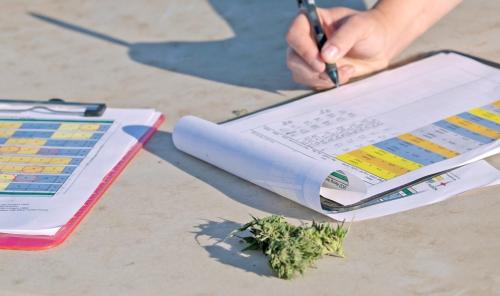
Hemp and the Law
Industrial hemp may only be grown in compliance with applicable state and federal law, including the 2014 and 2018 farm bills and the anticipated U.S. Department of Agriculture regulations. The following information is being provided for educational purposes only to inform licensed growers operating in compliance with applicable state and federal laws. Consult your local authorities, Department of Agriculture representatives, or personal attorney for questions regarding the legality of growing industrial hemp in your jurisdiction.
What is Industrial Hemp?
by V.D. Jeliazkov, J. Noller, S. Angima, S. Rondon, R. Roseberg, S. Summers, G. Jones, V. Sikora (Oregon State University Extension Service)
Introduction
Industrial hemp (Cannabis sativa L.) was grown as a commodity fiber crop in the United States from the mid-18th century until the mid-1930s. As in many other countries, C. sativa was banned and was considered an illegal crop in the U.S. for several decades.
In 2014, Section 7606 of the federal Agricultural Act of 2014, commonly called the Farm Bill, allowed the cultivation of industrial hemp within authorized pilot programs for “the plant Cannabis sativa L. and any part of such plant, whether growing or not, with a delta-9 tetrahydrocannabinol [THC] concentration of not more than 0.3 percent on a dry weight basis.”
Global Importance of Industrial Hemp
Industrial hemp is a temperate region crop; it grows best in more northern latitudes from the 42nd to 45th parallel. It grows well in the Pacific Northwest.
Industrial hemp is an annual cross-pollinating plant with rapid growth and development that results in significant biomass accumulation. Registered varieties of industrial hemp vary significantly in height and size. Two historical uses of industrial hemp are fiber and food. Industrial hemp seed oil, extracted from the grain, is valued as healthy table oil, and it has many applications in cosmetics, nutraceuticals and functional foods.
In recent years, Cannabis sativa has been rediscovered as a high-value crop and is quickly becoming established in the U.S. C. sativa can be used in many ways, including as a source of natural products of pharmacological interest. The various economic products of C. sativa are the basis for grouping hemp into four categories: (1) fiber hemp, (2) oilseed hemp (3) hemp products for medicinal markets, and (4) hemp products for recreational markets. Fiber and oilseed/grain hemp are collectively known as industrial hemp.
Fiber hemp products
Fiber hemp products historically have included textile, cordage and paper. China is the main producer of fine hemp textile fiber, which is often mixed with other natural fibers in the manufacture of fine linens. Several European Union countries, Eastern Europe, Russia and South Korea also are significant producers of hemp. With consumer preferences worldwide increasingly favoring natural products and production systems that are environmentally friendly, the market for textiles, fabrics and clothing that include fiber hemp has increased significantly.
Fiber hemp is also used in horticultural planting materials; biodegradable mulch; pressed and molded fiber products, including those used in the automobile industry; paper and pulp products (such as hygiene products, banknotes, filters, art papers, tea bags); building-construction products (such as fiberboards and fiber-reinforced cement boards); insulation materials; animal bedding (made from the woody core of the plant called hurds); plastic biocomposites; and compressed cellulose plastics. Due to its high biomass production, hemp shows promise as a bioenergy crop.
Hemp seed or grain
Hemp seed contains 20%–30% edible (fixed) oil; 25%–30% protein, which includes eight of the daily essential amino acids recommended for humans; 20%– 25% fiber; 20%–30% carbohydrates; and many essential nutrients and vitamins.
Humans have used hemp seed as food since ancient times. Grain or oilseed hemp products include hemp seed, seed flour, seed protein, seed powder, seed oil, and hemp meal. Nowadays, hemp grain is used in human health food because of the desirable ratio of omega-6 and omega-3 fatty acids in hemp oil. It is not yet legal to feed hemp to animals in the U.S.
Hemp seed oil is used in many cosmetics and as a substitute for other industrial oils. Hemp seed oil has a pleasant flavor and is used like olive oil as table oil and in salad dressing. Hemp seed oil should not be used for frying or baking; when heated at temperatures above 320°F (160°C), flavor declines, and it may produce toxic byproducts. Also, hemp seed and hemp seed oil do not have a long shelf life. Sterilization of hemp seed (which is required in North America when used for consumption) may foster rancidity of the oil within the seed.
Hemp seed should be stored in dark containers and refrigerated to extend the shelf life and preserve the quality. Most of the hemp grain imported in the U.S. comes from Canada, where industrial hemp has been legalized since 1998. Canada is one of the primary producers of oilseed hemp, and most of the Canadian hemp seed is exported to the U.S.
Hemp oil
There are three different oils from industrial hemp: cannabidiol (CBD) oil, essential oil, and seed fixed (fatty) oil. Cannabidiol oil is legal in many states and is being included in a wide variety of products, from sparkling water to lotion. However, CBD’s purported health benefits have not yet been verified by scientific research. Unlike the other major cannabinoid compound — tetrahydrocannabinol (THC) — CBD is classed as nonintoxicating and without “abuse liability,” which means it is not addictive.
Cannabidiol is known for a wide range of pharmacological activities, although there is still a need for research to clarify the exact mechanism of CBD action and its safety profile. A pharmaceutical-grade CBD extract was approved in 2018 by the FDA as a new medicine for the treatment of two rare forms of epilepsy in children. Another cannabis-based pharmaceutical that contains 1:1 THC and CBD has been on the market since 2010.
Hemp fibers
There are three different fiber cells in hemp stems: primary phloem, secondary phloem and xylem. The primary phloem includes the outer cells that provide long fibers. The inner cells generated by the cambium provide secondary phloem short fibers, and inside the cambium is the wood (hurds), which provides short fibers. The longer the fibers, the more valuable they are.
Primary bast fibers are the most commercially valuable of the hemp fibers, followed by the secondary bast fibers and then the wood core fibers. The fiber hemp plant height, stem diameter and other morphological features depend on the genotype (variety) and environment. Agronomic conditions (plant density, irrigation, fertilization, harvest time, etc.) play a critical role in plant morphology and fiber yield and quality.
